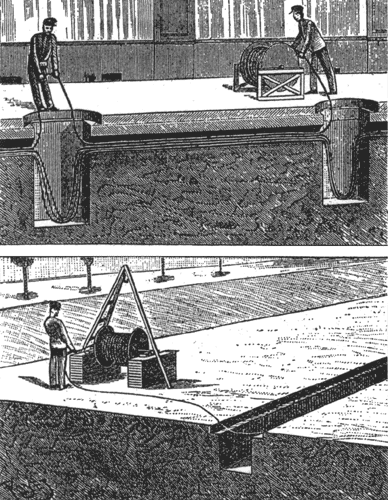[Trade Journal]
Publication: Electrical World
New York, NY, United States
vol. 14, no. 9, p. 147, col. 1-2
The Electric Subways of Paris.
At the close of 1888, the Municipal Council of Paris granted concessions for electric lighting in various quarters of Paris to the Edison, Popp, Sencier, Surry-Montaut and other companies, reserving to itself the right to put in a central station of its own at the Halles market.
Operating under these privileges, the first three companies have put in underground conduits, the types of which are shown in Figs. 1 to 4, taken from an article by M. Laffarque in La Nature. These subways are built of cement, sand and lime mixed, in which small ducts or troughs are made, above which is a bed of sand, on which rests the granite blocks or the asphalt of the roadway. All these conduits are not less than 1.20 metres from the houses, the municipality reserving the right to building immediately next to the houses. The methods of construction and of crossing streets, road beds, etc., are common to all the companies. In some little-frequented streets the conduits are only 1.50 metres below the surface; in others the cables are simply laid with a lead casing, but in the leading thoroughfares some of the conduits are as deep as 7.40 m., and they are connected together by subterranean galleries. Fig. 5 shows a subway of this kind 7.40 m. deep, with a species of man-hole near the houses .80 m. in diameter. In the lower part of this is a subterranean gallery 1.50 m. in height. To descend these small manholes iron ladders are used, such as are placed in sewers. Finally, from point to point are located large manholes of the kind shown in Fig. 6.
 |
| Figs. 1, 2, 3, 4, and 5. — the New Electrical Subways of Paris, France. |
The conduits having thus been made, the conductors were placed in them. The Edison Company places its cables, of bare silicon bronze wire, on brackets of galvanized iron, carried by porcelain insulators, Fig. 1. These in turn are supported by iron rods fastened to an iron cross support, secured in the masonry at the bottom of the conduit. The cables are held fast by the metal clips. The same method of using bare conductors has been adopted by the company for the transmission of power, as shown in Fig. 2. For taps along the streets the company has employed lead cables in wooden moldings treated with sulphate of copper. The Compagnie Parisienne d'Air Comprime uses the method shown in Fig. 8, with iron tubes 20 centimetres in diameter, in which the wires and cables are placed haphazard. The service of the Municipality is shown in Fig. 4, where the conductors are seen held up by hooks of vitrified iron inserted in the wooden linings. This plan allows a number of conductors to be placed in a limited space.
In order to draw in the cables, the Edison and Electric Power Companies unwind off large Drums, as shown in Fig. 6. The Popp Company, on the other: hand, leave a small wire in their pipes, and to this, wire the end of a cable is attached, so that it may be pulled through. Such a method results in many abrasions, leading to leaks, short circuits, etc., which is specially undesirable where a number of conductors lie together indiscriminately.
 |
| Fig. 6. — Putting Conductors in the New Paris Subways. |
The Popp Company is furnishing 44 Thomson-Houston arcs from a dynamo driven by a 50 h. p. compressed-air motor. The Edison Company is running a large number of incandescents at 110 volts, and has a number of arcs. The Electric Power Company is supplying 25 arcs, and the Municipal service will use the Edison system for continuous current work and Ferranti apparatus for alternating current work.
